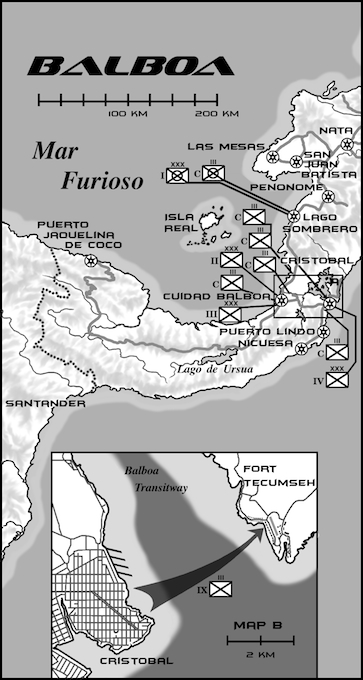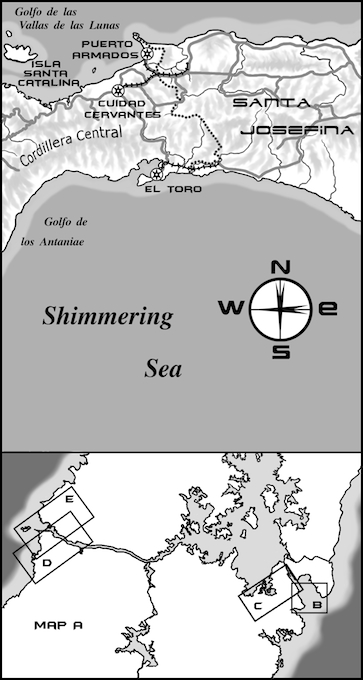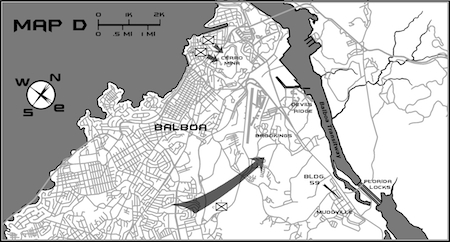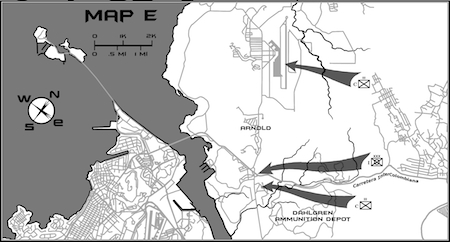Come and Take Them-eARC
Read Come and Take Them-eARC Online
Authors: Tom Kratman
Tags: #Military, #Science Fiction, #General, #Action & Adventure, #Fiction

Come and Take Them–eARC
Tom Kratman
Advance Reader Copy
Unproofed
BAEN BOOKS by TOM KRATMAN
A State of Disobedience
A Desert Called Peace
Carnifex
The Lotus Eaters
The Amazon Legion
Come and Take Them
Caliphate
Countdown: The Liberators
Countdown: M Day
Countdown: H Hour
With John Ringo
Watch on the Rhine
Yellow Eyes
The Tuloriad
Come and Take Them
This is a work of fiction. All the characters and events portrayed in this book are fictional, and any resemblance to real people or incidents is purely coincidental.
Copyright © 2013 by Tom Kratman
All rights reserved, including the right to reproduce this book or portions thereof in any form.
A Baen Books Original
Baen Publishing Enterprises
P.O. Box 1403
Riverdale, NY 10471
www.baen.com
ISBN: 978-1-4516-3936-0
Cover art by Kurt Miller
First printing, November 2013
Distributed by Simon & Schuster
1230 Avenue of the Americas
New York, NY 10020
Library of Congress Cataloging-in-Publication Data
t/k
10 9 8 7 6 5 4 3 2 1
Pages by Joy Freeman (www.pagesbyjoy.com)
Printed in the United States of America
For the very brave teacher, Victoria Soto, who should have
had a gun to balance her big brass balls, as she
placed her body between death and her little ones.
And for her principal, Dawn Hochsprung, who
charged bare-handed to the rescue, when she ought
to have been armed with more than fighting spirit.
As long as our country has such women,
hope is not lost.
And for Juliana, Patrick, and Cossima, may they never
need a woman like Victoria or Dawn to protect them.
Maps





MOLON LABE:
“Come—and if you succeed in that—
then you can take them.”
—Leonidas I, Agiad King of Sparta
What has gone before (5,000,000 BC through Anno Condita (AC) 472)
Long ago, long before the appearance of man, came to Earth the aliens known by man only as the “Noahs.” About them, as a species, nothing is known. Their very existence can only be surmised by the project they left behind. Somewhat like the biblical Noah, these aliens transported from Earth to another planet samples of virtually every species existing in the time period approximately five hundred thousand to five million years ago. Having transported these species, and having left behind various other, genengineered species, apparently to inhibit the development of intelligent life on the new world, the Noahs disappeared, leaving no other trace beyond a few incomprehensible and inert artifacts, and possibly the rift through which they moved from the Earth to the new world.
In the year 2037 AD a robotic interstellar probe, the
Cristobal Colon
, driven by lightsail, disappeared en route to Alpha Centauri. Three years later it returned, under automated guidance, through the same rift in space into which it had disappeared. The
Colon
brought with it wonderful news of another Earthlike planet, orbiting another star. (Note, here, that not only is the other star
not
Alpha Centauri, it’s not so far been proved that it is even in the same galaxy, or universe for that matter, as ours.) Moreover, implicit in its disappearance and return was the news that here, finally, was a relatively cheap means to colonize another planet.
The first colonization effort was an utter disaster, with the ship, the
Cheng Ho
, breaking down into ethnic and religious strife that annihilated almost every crewman and colonist aboard her. Thereafter, rather than risk further bloodshed by mixing colonies, the colonization effort would be run by regional supranationals such as NAFTA, the European Union, the Organization of African Unity, MERCOSUR, the Russian Empire and the Chinese Hegemony. Each of these groups were given colonization rights to specific areas on the new world, which was named—with a stunning lack of originality—“Terra Nova” or something in another tongue that meant the same thing. Most groups elected to establish national colonies within their respective mandates, some of them under United Nations’ “guidance.”
With the removal from Earth of substantial numbers of the most difficult portions of the populations of Earth’s various nations, the power and influence of transnational organizations such as the UN and EU increased dramatically. With the increase of transnational power, often enough expressed in corruption, even more of Earth’s more difficult, ethnocentric, and traditionalist population volunteered to leave. Still others were deported forcibly. Within not much more than a century and a quarter, and much less in many cases, nations had ceased to have much meaning or importance on Earth. On the other hand, and over about the same time scale, nations had become preeminent on Terra Nova. Moreover, because of the way the surface of the new world had been divided, these nations tended to reflect—if only generally—the nations of Old Earth.
Warfare was endemic, beginning with the wars of liberation by many of the weaker colonies to throw off the yoke of Earth’s United Nations.
In this environment Patrick Hennessey was born, grew to manhood, and was a soldier for many years. Some years after leaving service, Hennessey’s wife, Linda, a native of the Republic of Balboa, along with their three children were killed in a massive terrorist attack on Hennessey’s native land, the Federated States of Columbia. The same attack likewise killed Hennessey’s uncle, the head of his extended and rather wealthy family. As his dying testament, Uncle Bob changed his will to leave Hennessey with control over the entire corpus of his estate.
Half mad with grief, Hennessey, living in Balboa, ruthlessly provoked and then mercilessly gunned down six local supporters of the terrorists. In retaliation, and with that same astonishing bad judgment that had made their movement and culture remarkable across two worlds, the terrorist organization, the Salafi
Ikhwan
, attacked Balboa, killing hundreds of innocent civilians, including many children.
With Balboa now enraged, and money from his uncle’s rather impressive estate, Hennessey began to build a small army within the Republic. This army, the
Legion del Cid,
was initially about the size of a reinforced brigade, though differently organized. For reasons of internal politics, Hennessey began to use his late wife’s maiden name, Carrera. It was as Carrera that he became well known to the world of Terra Nova.
The legion was hired out to assist the Federated States of Columbia in a war against the Republic of Sumer, a nominally Islamic but politically secular—indeed fascist—state that had been known to have supported terrorism in the past, to have used chemical weapons in the past, and to have had a significant biological warfare program. It was widely believed to have been developing nuclear weapons, as well.
Against some expectations, the
Legion del Cid
performed quite well. Equally against expectations, its greatest battle in the campaign was against a Sumeri infantry brigade led by a first rate officer, Adnan Sada, who not only fought well but stayed within the customs, rules, and laws of war.
Impressed with the legion’s performance (even while loathing the openly brutal ways it had of enforcing the laws of war), and needing foreign troops badly, the War Department of the Federated States offered Carrera a long-term employment contract. Impressed with Sada, and with some of the profits from the contract with the Federated States, Carrera likewise offered to not only hire, but substantially increase, Sada’s military force. Accepting the offer, and loyal to his salt, Sada revealed seven nuclear weapons to Carrera, three of which were functional and the rest restorable. These Carrera quietly removed, telling no one except a very few,
very
close subordinates.
The former government of Sumer had a cadre and arms for an insurgency in place before the Federated States and its allies invaded. In Carrera’s area of responsibility, this insurgency, while bloody, was contained through the help of Sada’s men and Carrera’s ruthlessness. In the rest of the country, however, the unwise demobilization of the former armed forces of the Republic of Sumer left so many young men unemployed that the insurgency grew to nearly unmanageable levels. Eventually, Carrera’s area of responsibility was changed and he was forced to undertake a difficult campaign against a city, Pumbadeta, held by the rebels. He surrounded and starved the city, forcing women and children to remain within it until he was certain that every dog, cat and rat had been eaten. Only then did he permit the women and children to leave. His clear intention was to kill every male in Pumbadeta capable of sprouting a beard.
After the departure of the noncombatants, Carrera’s legion continued the blockade until the civilians within the town rebelled against the rebels. Having a rare change of heart, Carrera aided the rebels against rebellion to take the town. Thereafter nearly every insurgent found within Pumbadeta was executed, along with several members of the press sympathetic to the rebels. The few insurgents he—temporarily—spared were sent to a surface ship for
rigorous
interrogation.
With the war in Sumer winding down, the Federated States, now under Progressive rather than Federalist leadership, unwisely fired Carrera and his legion. And, as should have been predicted, the terrorist money and recruits that had formerly been sent to Sumer, where the Salafi cause was lost, were instead redirected to Pashtia, where it still had a chance. The campaign in Pashtia then began to flow against the Federated States and its unwilling allies of the Tauran Union.
More than a little bitter at having his contract violated and being let go on short notice, Carrera exacted an exorbitant price from the Federated States before he would commit his forces to the war in Pashtia. That price being paid, however, and in gold, he didn’t stint but waged a major—and typically ruthless—campaign to restore the situation in Pashtia, which had deteriorated badly under Tauran interference and faint support.
Ultimately, Carrera got wind of a major meeting taking place across the nearby border with Kashmir between the chief of the United Earth Peace Fleet and the emir of the terrorists, the Salafi
Ikhwan
. He attacked and in the attack and its aftermath killed thousands, captured hundreds, and seized a dozen more nuclear weapons, gifts of the UEPF to their terrorist allies. One of these weapons Carrera delivered to the capital of the major terrorist supporting state of Yithrab. When detonated, this weapon not only killed the entire clan of the chief of the Salafi
Ikhwan
, but also at
least
a million citizens of that city. In the process, he framed the Salafis for the detonation.
That destruction, seemingly at the hand of an Allah grown weary of terrorism, along with the death or capture and execution of the core of the Salafi movement in the attack across the Pashtian-Kashmiri border, effectively ended the terrorist war on Terra Nova.
The price to Carrera had also been heavy. With the end of the war with the terrorists, and having had more revenge against the murderers of his family than any man ought desire, he collapsed, physically, mentally, and emotionally. Recovery was slow and guarded by his second wife, Lourdes.
Unfortunately, he was still needed by his adopted home of Balboa. Having arranged for Carrera’s wife to be disarmed, Legate Jimenez and Sergeant Major McNamara ultimately persuaded him back to active duty. There followed a vicious no-holds-barred-and-little-quarter-given war with the quasi sovereign drug cartels of Santander, along with an attempted
coup d’état
, by the treacherous Legate Pigna. This was ultimately foiled by Lourdes, with the help of the Volgans of the Twenty-Second Tercio. In the same coup, the rump of the old, oligarchic Balboan state was reabsorbed into the rest of the country, the oligarchs and their lackeys being driven from the country or killed. Very nearly the last remaining scion of the oligarchs, and the man who had set up Carrera for assassination, Belisario Endara-Rocaberti, had fled to Hamilton, in the Federated States, where he’d done everything up to and including giving the use of his wife to the president of the Federated States to get the Parilla regime overthrown. But, while the president of the FSC was more than willing to make extensive use of Mrs. Rocaberti or, indeed, pretty much anything in a skirt, he really had no interest in getting the FSC into a war.
It remains now to remove the Tauran Union from its death grip around Balboa’s mid-section. To this end, no resource will be left unmobilized.